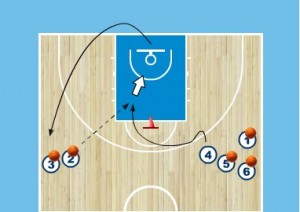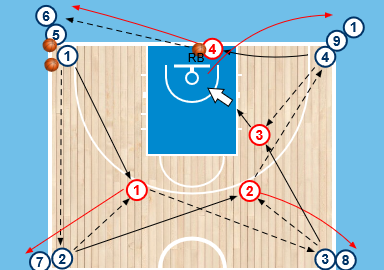Basketball drills
- One person shoots free throws.
- Two other players stand behind the one who throws the free throw.
- According to the rules of the game
- Once the ball is gone the three players go for the rebound.
- If the person who made the free throw has the ball, he can make another free throw.
- If he doesn't have the ball, the 2 other players go to the other side of the court to attack, 2 against 1.
- If attacker is pressured by defender then go to free man, otherwise keep going until lay-up.
- The next three players get ready to execute the exercise.
Warm-up
- dribble over and over again right hand
- dribble over and left hand again
- low dribble over and right again
- low dribble over and to the left
- high dribble over and right again
- high dribble over and left again
- protection dribble with a hand change every 2 or 3 dribbles (2 times over and over)
- quick dribble over and over again with crossover at the free throw centre and free throw line.
- Players stand ready at the halfway line. The first one has a ball (then 2 without the ball).
- X1 makes lay-up
- X2 takes rebound and passes in (after scoring!)
- X3 runs around the pot and starts defending
- X1 and X2 attack to the other ring
- variation: with 5
- X1 makes lay-up
- X2 takes rebound and gives in (after score!) to X3
- X3 dribbles over, X1 and X2 fill in the outer lines.
- X4 walks around the basket near the baseline and defends.
- X4 runs around the ball at the halfway line (other side) and defends.
- 2 numbers a few meters apart
- x number of chesst pass
- x number of bounce passes
- x number of overhead pass
- x number of bounce pass out
- x number of baseball pass
- Add if necessary
- Defender
- pass from the dribble
- 2 teams
- take turns shooting from all the blocks and dashes on the bucket edge
- and the free throw line together 5 hit
- Two teams both 1 basket 1 team starts with the ball and plays 1v0 at the basket of the other team 1 chance
- Then the other team attacks the person from the first team now goes to defend 1v1 so in the other direction
- On this side, another person of the first team joins and it becomes 2v1
- Etc.
Try to hit as far as possible without error or loss of ball.
- Players stand in pairs (about the same size).
- On the whistle, the player with the ball dribbles to the opposite side while the player without the ball can do heavy defence.
- There may be physical pressure but no mistakes.
- Players stop when they have lost control of the ball or when the defence has taken it away.
- If the player with the ball touches the opposite side, he may dribble again in the next round but against a different defence.
- Stand in pairs in the middle of the room.
- You do with this pair 'stone - paper - scissors' and who loses must tap the winner as soon as possible.
- The winner must try to tap the wall on his side of the room as quickly as possible.
- Half have a ball, the other half do not.
- Players are mixed up.
- At whistle: make eye contact and pass to someone without ball.
- Varying :
- Left hand and right hand dribble,
- vary passes
This drill can serve well as a warming up drill (passing / finishing) but is also a good breakdown for a "scissor" play, or "split the post". You can expand the drill to include other options that may or may not be used in your set play. You start off basic, simple, and as your team is ready, you expand the exercise further and further.

- The exercise starts with two rows on two spots (e.g. 2 guard spots).
- If you have a larger team, you work on 2 baskets. Again, we would like to see everyone finish as many balls as possible.
- So make the groups as small as possible, but at least 4-6 players per basket.
- #1 starts the exercise by making a preliminary move ("setting up" the defender) and cutting tightly over the pawn (or chair).
- As a trainer you can also stand here for a while as a high-post so that it becomes recognizable for the players.
- #4 passes the ball to the cutting in #1 and after his pass he immediately makes another pre-move and cuts across the pawn in the same way, then gets the ball from #2.
- Rotation: Each player catches his own ball, and joins the line from which he received the ball. The exercise continues in this manner continuously.
Variations:
- Vary speed. The players must first master the technique of cutting in. Set up a man, push off and accelerate, etc. (see teaching points). Then increase the pace.
- Receive and shoot the ball;
- Make a pop-out (when a defender passes underneath) and shoot;
- Train aggression with pad, unbalance players when cutting in;
- After cutting in, offer the ball at the low post and finish with a post move (also think of countermoves), use pads here too;
- Work with a high-post player (trainer or one of the players): Pass the ball to the high-post first and then: hand-off / hi-lo, etc (depending on your own options);
- Eventually work with defenders involved as well;
Teaching Points:
- Set up defenders;
- Push off on the outer foot and accelerate (change of direction = change of speed)
Aggressive cutting in!
- Cut straight over the pawn, do not make wide turns ("shoulder to shoulder");
- Communication in the passing game, seeking eye contact, clearly asking for the ball with the front hand, asking in front of the man and running into the ball;
- Finish from the left side with the left hand, and the same applies for the right side;
- Divide the players into 2 groups.
- Set up a track on both sides of the court where the players have to dribble in between.
- At the end of the course they can finish on goal.








